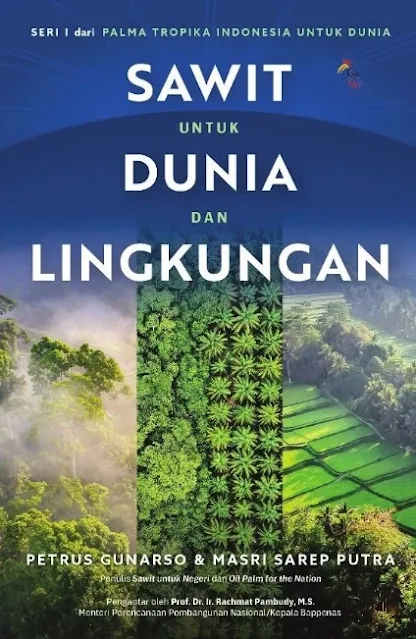A book that Researches, Writes, and Publishes on Palm Oil with the Balanced Approach
 |
A book that researches, writes, and publishes on palm oil with the balanced approach. Published by LLD. |
Authors: Petrus Gunarso & Masri Sareb Putra
Title: Sawit untuk Dunia dan Lingkungan
Category: Economics, Environment
Publisher: Dayak Literacy Institute
Publication Year: 2025
ISBN: 978-623-5890-87-6
Pages: 246
Country: Indonesia
Language: Indonesian
Dimensions: 15x23 cm
Price: Rp. 150,000,-
🌍 DAYAK TODAY | JAKARTA: Palm oil has emerged as a pivotal issue in global trade, often at the center of heated debates and economic conflicts.
Western nations frequently oppose its expansion, not purely on environmental grounds but as part of a larger economic rivalry —an outright trade war. This has led to the rise of “post-truth” narratives, where facts are overshadowed by misleading claims designed to sway public opinion.
Read Pidato Prabowo Terkait Ekstensifikasi Sawit
The reality, however, is that palm oil is a neutral product, neither inherently good nor bad, but one whose benefits and challenges should be assessed based on data, not rhetoric.
This book is the product of an exceptional collaboration between a seasoned researcher (Petrus Gunarso) and a hands-on industry practitioner (Masri Sareb Putra), bringing together a wealth of empirical research, firsthand experience, and a critical analysis of the palm oil industry.
Drawing extensively from primary data—including the latest reports from World Oil—this book serves as both a guide and a reference for researchers, policymakers, industry professionals, manufacturers, and importers looking for an in-depth, balanced examination of the sector.
Read Dayak (Harus) Menikmati Booming sawit di Tanah Warisannya
The global demand for vegetable oil has skyrocketed over the decades, increasing from 16 million tons in 1960 to a staggering 228 million tons in 2024, with an annual growth rate exceeding 3 million tons. If this demand were to be met solely through seasonal crops like soybeans, rapeseed, or sunflowers, the world would require exponentially more agricultural land—potentially leading to even greater environmental destruction. Palm oil, with its unrivaled yield per hectare, presents the most efficient solution to meet the world’s growing need for vegetable oil without disproportionately expanding agricultural footprints.
In Indonesia, the palm oil industry has seen unprecedented growth, particularly after the political and economic shifts following the 2000 reform era. As decentralization policies took effect, vast tracts of land—previously designated for forestry concessions under the New Order regime—were repurposed for palm oil cultivation, particularly in Riau, Central Kalimantan, and East Kalimantan. While this expansion has brought substantial economic benefits, it has also triggered pressing environmental challenges, including deforestation, land-use changes, and biodiversity loss.
A Comprehensive Examination
This book takes a nuanced and data-driven approach, offering a well-rounded perspective on the palm oil industry from multiple angles:
- Environmental Impact: Palm oil cultivation’s role in deforestation, carbon emissions, and habitat loss has been widely criticized. However, the book also explores how sustainable practices, including RSPO (Roundtable on Sustainable Palm Oil) certification and precision agriculture, could mitigate these issues.
- Economic and Social Benefits: Millions of smallholder farmers depend on palm oil as their primary source of livelihood. The book details how the industry has lifted entire communities out of poverty, increased rural infrastructure development, and contributed significantly to national economies.
- Supply Chain and Processing Industry: Palm oil is more than just a raw commodity; it serves as a crucial input for a wide range of industries, from food and cosmetics to biofuels and pharmaceuticals. The book highlights how global supply chains operate and what role palm oil plays in meeting worldwide consumer demand.
- Regulatory and Trade Challenges: With increasing pressure from international trade policies, environmental regulations, and shifting consumer preferences, the palm oil industry faces complex challenges. The book provides a deep dive into the geopolitical and economic forces shaping the future of the sector.
Why This Book Matters
With polarized narratives dominating the discourse on palm oil, this book offers a refreshing departure from sensationalism, replacing emotion-driven debates with facts, figures, and objective analysis. It is an indispensable resource for anyone looking to understand palm oil beyond the headlines —whether they are government officials navigating policy decisions, business leaders optimizing supply chains, environmental advocates seeking realistic solutions, or scholars conducting research on global agribusiness trends.
Read Dampak Fluktuasi Harga Minyak Nabati dan Sawit bagi Petani Dayak di Kalimantan
Written in a clear, engaging style, Palm Oil for the World and the Environment is not just a book—it is a definitive guide for the future of sustainable and responsible palm oil production in a rapidly evolving world.
-- Rangkaya Bada
